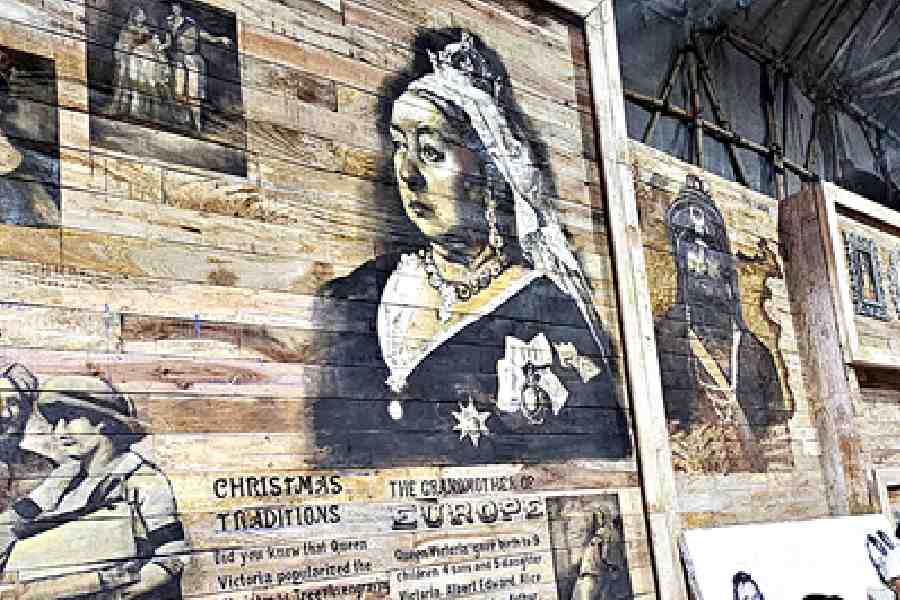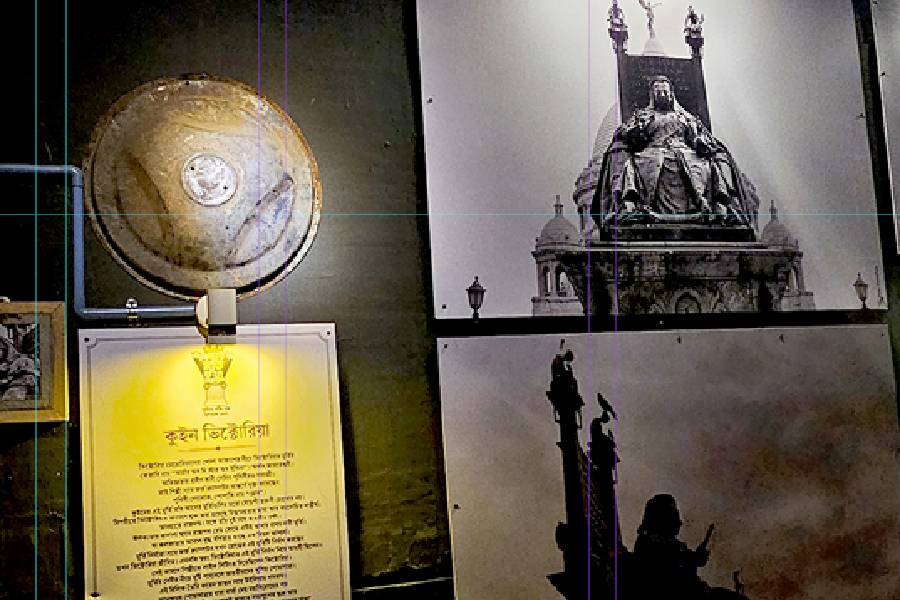Queen Victoria is an imposing presence this year at three pandals on very different themes executed by eminent theme-makers.
If one traces the history of Kohinoor, from the mine to the crown, another is on the exploitation of indigo and cotton cultivators and weavers in the colonial times, while the third one celebrates Calcutta’s public sculptures of the Raj era.
A visitor faces the empress of British India on walking into the Dum Dum Tarun Dal pandal. She stands erect at seven and a half feet, looking haughtily over all she surveys, on an 8ft pedestal, holding the sovereign’s sceptre in one hand and the orb in the other. Under her feet is a weaver’s loom that she seems to be crushing.

A sketch of Queen Victoria wearing a Kohinoor brooch on a wooden board at Beliaghata 33 Palli.
“Our theme is sada aar neel (white and blue). White is the colour of muslin, a fabric that Bengal was globally known for, while blue represents indigo, a plant that farmers were forced to grow in place of food crops to extract a dye that was in high demand in Europe and therefore a lucrative export for British planters,” said Pradip Das, the theme-maker.
Victoria’s figure symbolises colonialism destroying the indigenous garment trade to boost the mechanised cotton industry in Manchester. Replicas of uniforms of British soldiers hang along the pandal walls.
But a revival is promised in the presence of three weavers from a Burdwan village who weave a muslin cloth on the spot in shifts. “They will finish by Dashami,” Das said.
Victoria’s larger-than-life sketch on a wooden panel is the final stop of a journey, traced at Beliaghata 33 Palli, of Kohinoor, India’s most famous diamond. Theme-maker Samrat Bhattacharya takes visitors on a reverse journey, starting with a newspaper clipping which announces the arrival of the gem on British shores, alongside other trivia related to the queen.
Other figures relevant to the diamond’s history, from Maharaja Ranjit Singh of Punjab to Nader Shah, who looted it from the Mughal peacock throne, have also been sketched alongside smaller portraits of each monarch through whose hands the gem passed. The idol is placed in a mine and the stone, a replica in glass brought from Jaipur, hangs in a locket on the chest.

Pictures of Queen Victoria's statue, installed at the Victoria Memorial's north gate, on display at the Purbachal Shakti Sangha pandal.
At theme-maker Partha Dasgupta’s ode to the city’s colonial street sculptures at Purbachal Shakti Sangha in Haltu, the bronze Victoria in front of her memorial in central Calcutta is one of the statues highlighted through multiple photographs.
It was the first woman’s statue to have been installed on Red Road and the queen had even given a sitting to the sculptor, Sir George Frampton, mentions the accompanying note on the pandal wall. The statue was subsequently removed to its current spot in front of the memorial’snorth gate.
The queen is also present in a silhouette on the dress of the fairy on top of the monument that towers over visitors inside the pandal. There is also a distinct influence of the Victoria statue in the idol, with little Ganesh in her lap.

The idol at Purbachal Shakti Sangha, bearing an influence of the Victoria Memorial statue.
“Other than the Ganesh-janani iconography of Birbhum, and the Madonna and child series of the Italian painter Raphael, the idol draws from the demeanour of the seated Victoria of Calcutta. Durga holds a sword, rather than a trident, in the upright manner of the sovereign’s sceptre. Sartorial influence of the Devi’s long dress can be traced to the robes of the Star of India that the empress is clad in,” Dasgupta pointed out.
The research for the pandal, comprising information on statues installed in public spaces right down to the present day, will be handed over as a compendium to the Calcutta Municipal Corporation.










